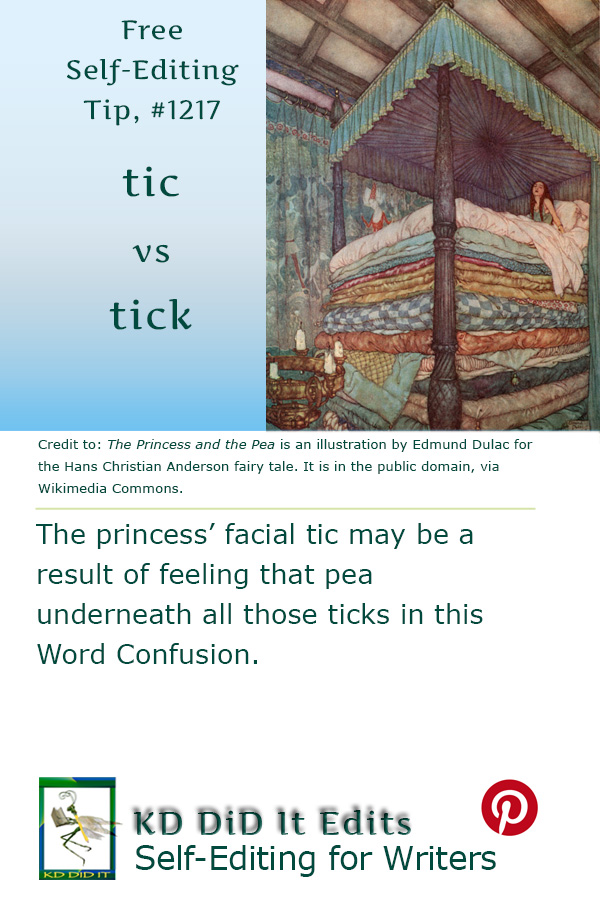It was “A nervous tick jerked his face once, twice” that caught my attention. I didn’t know that ticks could get nervous. Nor that they were strong enough to jerk someone’s face.
Of course, the author might have meant tic . . .
Yep, that’s the word confusion tic vs tick, a pair of heterographs (a subset of homophone) which are both nouns and verbs.
A tic is a nervous movement.
A tick is most commonly thought of as an insect that bites or the sound of a clock. It can also refer to anger, a checking off of things on a list or an accounting, the covering for a mattress, a small coloration, or movements.
Word Confusions . . .
. . . started as my way of dealing with a professional frustration with properly spelled words that were out of context in manuscripts I was editing as well as books I was reviewing. It evolved into a sharing of information with y’all. I’m hoping you’ll share with us words that have been a bête noire for you from either end.
If you found this post on “Tic versus Tick” interesting, consider subscribing to KD Did It, if you’d like to track this post for future updates.
| Tic | Tick |
|---|---|

Person’s Hands by Shiny Diamond is in the public domain, via Pexels. — Rubbing one’s hands can be a nervous tic. |

Deer Tick by Stuart Meek is under the CC BY-SA 2.0 license, via Wikimedia Commons. |
| Part of Grammar: | |
| Noun 1; Suffix 2; Verb, intransitive 1
Plural for the noun: tics Third person present verb: tics |
Noun 1, 2, 3, 4; Verb 1, intransitive & transitive
Plural for the noun: ticks Third person present verb: ticks |
| Noun: An habitual spasmodic contraction of the muscles, most often in the face 1
An idiosyncratic and habitual feature of a person’s behavior Suffix: Verb, intransitive:
|
Noun: A regular short, sharp sound, especially that made by a clock or watch 1
[Mainly British] A mark (✓) used to indicate that an item in a list or text is correct or has been chosen, checked, or dealt with
[Informal] A unit on a scale
[Stock Market] The smallest recognized amount by which a price of a security or future may fluctuate [Manège] A jumping fault consisting of a light touch of a fence with one or more feet A small contrasting spot of color on the coat of a mammal or the feathers of a bird A parasitic arachnid that attaches itself to the skin of a terrestrial vertebrate from which it sucks blood, leaving the host when sated 2
[Textiles] A fabric case stuffed with feathers or other material to form a mattress or pillow 3
[Commerce; informal; British] Account or credit, especially in the phrase on tick 4 Verb, intransitive: Verb, transitive: To count or record with the sound of ticks [Slang; tick off] To make angry |
| Examples: | |
| Noun: Most people who have Tourette’s have tics but it isn’t unheard of for people without Tourette’s to have tics. “As is the case in its trigeminal counterpart, tic douloureux, hemifacial spasm has a diverse array of potential etiologies” (Palacios, 55&8211;56). I began with the kind of generalization that was one of my primary tics as a writer. “One tic he has is to apologize even when something is not his fault” (Brewer). There are factors that affect the frequency of ticcing. Generally a sign of anxiety or insecurity, a tic begins as a deliberate movement that gradually becomes unconscious. She developed a tic in her left eye. Suffix: “Each of the casings houses a blood-pressure console with LED systaltic and diastolic readouts and blood-pressure gauge, a bench, a standing scale with video readout (not included in the small model) and a 3-foot tall communications board” (Vita). We have taken an extremely analytic approach to targeting customers. My son is very athletic. Verb, intransitive: “Kids with provisional tic disorder often stop ticcing on their own and don’t need treatment” (Jacobson). Don’t look now, but he hasn’t ticced all day. |
Noun: There’s something soothing about a clock’s ticking. I’ll be with you in a tick. You can tick that one off. Buy when interest rates move up a tick. Tick size refers to the minimum price movement of a trading instrument in a market. Stroller got round the course without even a tick. My Sascha has a tick on her face. Be careful out in the fields . . . the ticks are fierce this summer. “Ticks are obligatory blood-feeding arthropods that belong to the subclass Acari, order Ixodida, and three families: Ixodidae (hard ticks), Argasidae (soft ticks), and Nuttallielidae” (Kotál). “The study of a mummified young dog dated to the Roman period suggests a significant infestation by two blood sucking ectoparasites, respectively the brown dog tick Rhipicephalus sanguineus Latreille, 1806 (Acari: Ixodidae), the louse fly Hippobosca longipennis Fabricius, 1805 (Diptera: Hippoboscidae) as well as puparia of sarcosaprophagous flies (Diptera: Sarcophagidae and Calliphoridae), a potential source of myiasis” (Huchet, 165-175). Mam made a tick filled with feathers. I don’t think much of this tick; all the feathers are coming through. Verb, intransitive: We got more nervous as the clock ticked. Helen could hear the machines ticking away. He was curious about what makes people tick. Verb, transitive: The clock was ticking the hours. The taxi meter was ticking the fare. She ticked off each name on the list. She really knows how to tick me off! |
| Derivatives: | |
| Adjective: tick-borne Noun: tick-tock, ticker Verb: tick-tock |
|
| Phrasal Verb | |
| tick along tick away tick away something tick by tick off tick off someone tick off something tick over tick past tick someone off tick something away tick something off |
|
| History of the Word: | |
| Early 19th century, from the French, from the Italian ticchio. |
|
C’mon, get it out of your system, bitch, whine, moan . . . which words are your pet peeves? Also, please note that I try to be as accurate as I can, but mistakes happen or I miss something. Email me if you find errors, so I can fix them . . . and we’ll all benefit!
Satisfy your curiosity about other Word Confusions on its homepage or more generally explore the index of self-editing posts. You may also want to explore Book Layout & Formatting Ideas, Formatting Tips, Grammar Explanations, Linguistics, Publishing Tips, the Properly Punctuated, Writing Ideas and Resources, and Working Your Website.
Resources for Tic versus Tick
Some of these links may be affiliate links, and I will earn a small percentage, if you should buy it. It does not affect the price you pay.
Apple Dictionary.com
Brewer, Robert Lee. “Tic vs. Tick (Grammar Rules).” Writer’s Digest. 31 Jan 2022. Accessed 22 Sept 2023. <https://www.writersdigest.com/write-better-fiction/tic-vs-tick-grammar-rules>.
Collins Dictionary: tic
Dictionary.com: tick
The Free Dictionary: tic, tic douloureux, tick
Huchet, J.B., C. Callou, R. Lichtenberg, and F. Dunand. “The Dog Mummy, the Ticks and the Louse Fly: Archaeological report of severe ectoparasitosis in Ancient Egypt.” Science Direct. vol 3. no 3. Sept 2013. Accessed 21 Sept 2023. https://doi.org/10.1016/j.ijpp.2013.07.001. <https://www.sciencedirect.com/science/article/abs/pii/S1879981713000764>.
Jacobson, Rae. Dr Wendy Nash (clinical expert). “Tics and Tourette’s: What to do (and not do) if your child develops a tic.” Child Mind Institute. 17 July 2023. Accessed 22 Sept 2023. <https://childmind.org/article/tics-and-tourettes/>.
Kotál, Jan, Helena Langhansová, Jaroslava Lieskovská, John F. Andersen, Ivo M.B. Francischetti, Triantafyllos Chavakis, Jan Kopecký, Joao H.F. Pedra, Michail Kotsyfakis, and Jindřich Chmelař. “Modulation of Host Immunity by Tick Saliva.” Journal of Proteomics. vol 128. Science Direct. 14 Oct 2015. Accessed 21 Sept 2023. <https://www.sciencedirect.com/science/article/abs/pii/S1874391915300610>.
Palacios, Enrique, Radia Ksayer, and Jeremy Nguyen. “An Atypical Presentation of Hemifacial Spasm Secondary to Neurovascular Compression.” Ear, Nose and Throat Journal. 97(3). 2 Mar 2018. Accessed 21 Sept 2023. PMID: 29554395. DOI: 10.1177/014556131809700316. <https://pubmed.ncbi.nlm.nih.gov/29554395/>.
“Vita-State Monitor Usage Increases.” Chain Drug Review. 3 July 1989. Accessed 21 Sept 2023.
Pinterest Photo Credits
The Princess and the Pea is an illustration by Edmund Dulac for the Hans Christian Anderson fairy tale. It is in the public domain, via Wikimedia Commons.


